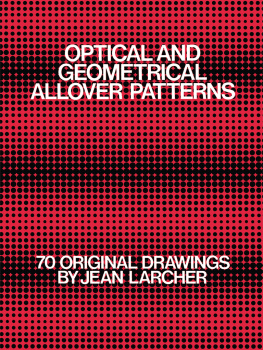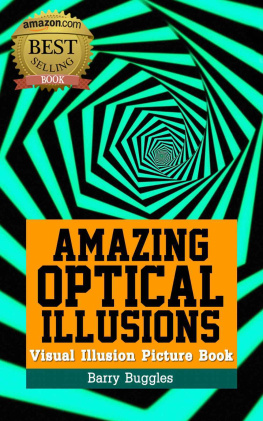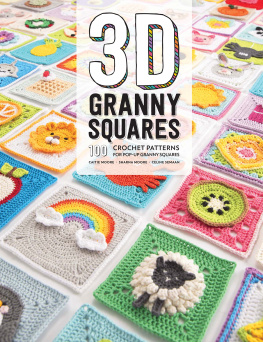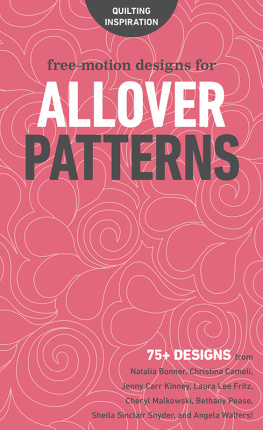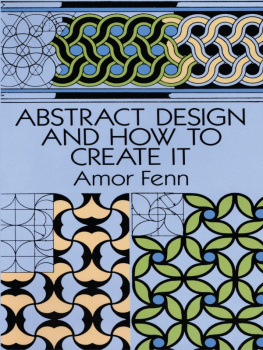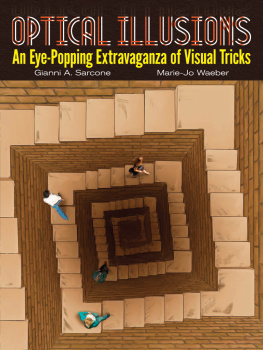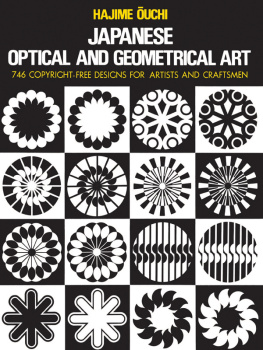
OPTICAL and GEOMETRICAL ALLOVER PATTERNS

OPTICAL and GEOMETRICAL ALLOVER PATTERNS
70 Original Drawings
by JEAN LARCHER Dover Publications, Inc., New York Copyright 1979 by Jean Larcher. All rights reserved.
Optical and Geometrical Allover Patterns: 70 Original Drawings is a new work, first published by Dover Publications, Inc., in 1979. DOVER Pictorial Archive SERIES This book belongs to the Dover Pictorial Archive Series. You may use the designs and illustrations for graphics and crafts applications, free and without special permission, provided that you include no more than ten in the same publication or project. For permission for additional use, please email the Permissions Department at or write to Dover Publications, Inc., 31 East 2nd Street, Mineola, New York 11501.
However, resale, licensing, republication, reproduction or distribution of any illustration by any other graphic service, whether it be in a book or in any other design resource, is strictly prohibited. International Standard Book NumbereISBN-13: 978-0-486-14411-5 Manufactured in the United States by Courier Corporation 23758302 www.doverpublications.com
AVANT-PROPOS
Les diffrentes tudes prsentes dans ce livre sont le fruit dune dmarche logique issue des nombreuses annes que jai consacres lOp-Art. Les Editions Dover lors dun ouvrage prcdent (1974) mavaient dj donn loccasion daborder ce sujet. Ici des dessins originaux regroups par thme, aboutissent dabord une recherche purement optique due au contraste parfois optimum du noir et du blanc et aux consquences qui en dcoulent (saturation optique, vibrations, mouvement virtuel, illusions visuelles, etc.), dautre part llaboration de dessins sans marge, sans limite, devenant de vritables trames. Ces rseaux gometriques peuvent stendre dune manire systmatique, rgulire et continue malgr certains incidents, commes les dgrads par exemple, ceux-ci se renouvelant linfini galement. Les travaux de peintres tels que Vasarely, lorigine, puis surtout de Bridget Riley, Morellet, Sol Lewitt et quelques autres mont conduit aborder lide du dessin rptitif, mcanique issu dun processus sriel de faon effacer une composition trop subjective due au hasard ou linspiration exalte du moment.
Ces dessins procdent donc des tudes, observations et conclusions que jai tires de certains phnomnes que lopposition du noir et du blanc peuvent occasionner. Les tudiants et professeurs en design, ainsi que les designers professionnels pourront dvelopper, exploiter et retravailler ces thmes proposs, de nouvelles solutions souvriront alors eux. Je pense dautre part quavec laide de la technologie et suffisamment dimagination cratrice, le film, la vido, lordinateur, peuvent tre dexcellents outils la disposition du designer pour manipuler, dformer, amplifier jusqu des dimensions architectoniques ces dessins et passer ainsi du plan au volume puis lespace. Avec de la rflexion, de la logique et de limagination, des solutions et des effets encore plus intressants pourront tre obtenus. Cest avant tout une rflexion sur la vision que je propose dans cet ouvrage, lobservateur lucide et attentif sera confront de multiples phnomnes rtiniens qui pourront dailleurs tre diffrents suivant les observateurs eux-mmes. De ce mouvement en puissance virtuelle se dclenchera, je le souhaiterais, une rflexion-interrogation, sur la vision des choses en gnral.
Et si jai port mon choix depuis longtemps sur ce chromatisme binaire quest le noir et blanc, cest bien dans un souci de radicaliser le propos. Lapport du subjectif et de lmotif de la couleur tant cart, lobservateur pourra apprendre regarder et non pas voir. Jean Larcher 
PREFACE
The various studies offered in this book represent a logical step resulting from the many years I have devoted to Op Art. In a previous book (1974), Dover Publications had already given me the opportunity of treating this subject. Here, original drawings, grouped thematically, lead first of all to a purely optical experiment, based on the contrastat times optimumof black and white and on the consequences of this contrast (optical saturation, vibrations, potential movement, visual illusions, etc.), and then to the working out of marginless, limitless drawings which become true screens or grids. These geometric networks can be extended in a systematic, regular and continuous manner, if one excepts certain difficulties, such as the shading off of tonesand these too can be repeated infinitely.
The work of such painters as Vasarely, at the outset, then especially Bridget Riley, Morellet, Sol Lewitt and a few others, led me to deal with the idea of a repetitive, mechanical design derived from a serial process, one that would do away with an overly subjective composition that was the result of chance or the emotional inspiration of the moment. Thus these designs proceed from the studies, observations and conclusions that I have drawn from certain phenomena that can be brought about by the opposition of black and white. Design students and teachers, as well as professional designers, will be able to develop, utilize and rework these suggested themes, and will then come upon new solutions. Moreover, I believe that, with the aid of technology and enough creative imagination, film, TV and the computer can be excellent tools available to the designer for manipulating, deforming and amplifying these designs to architectonic proportions, thus moving from the plane to three dimensions and then to space. With reflection, logic and imagination, even more interesting solutions and effects will be obtainable. What I set forth in this book is principally a meditation on vision.
The clear-minded and attentive viewer will come face to face with multiple retinal phenomena which may be different for different observers. I hope that this potential action will lead to a state of reflection and questioning on the nature of vision in general. And if I have long championed the binary color scheme of black and white, it has been with the purpose of bringing the issue to a head. Once the subjective and emotional elements inherent in color have been set aside, the viewer will be able to learn how to look and not merely see. Jean Larcher 







Next page
